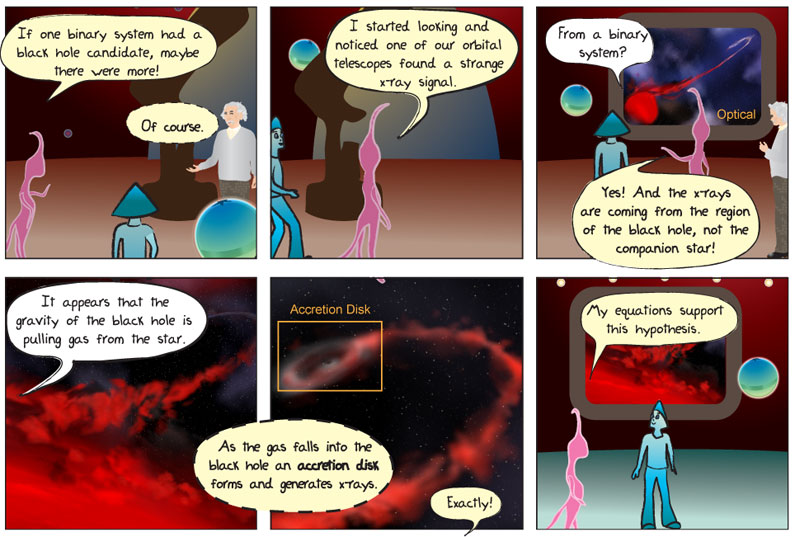
Comic Transcript
Panel 1.
Professor Ahmix: If one binary system had a black hole candidate, maybe there were more!
Hologram Einstein: Of course.
Panel 2.
Professor Ahmix: I started looking and noticed one of our orbital telescopes found a strange x-ray signal.
Panel 3.
Alkina: From a binary system?
Professor Ahmix: Yes! And the x-rays are coming from the region of the black hole, not the companion star!
Panel 4.
Alkina: It appears that the gravity of the black hole is pulling gas from the star.
Panel 5.
Hologram Einstein: As the gas falls into the black hole an accretion disk forms and generates x-rays.
Professor Ahmix: Exactly!
Panel 6.
Professor Ahmix: My equations support this hypothesis.
What does it mean?
Accretion Disk – A disk of matter that forms when material is transferred to a gravitationally massive body, such a black hole. For black holes, the disks form outside the event horizons. For other objects, such as neutron stars or white dwarfs, the disks can extend down to the stellar surfaces. Friction and other forces heat the disks, which then emit a a wide range of different types of electromagnetic radiation including x-rays.
In human speak please!
Our atmosphere blocks x-rays from reaching the surface of the Earth. In the 1960s, scientists sent rockets above the atmosphere with instruments designed to detect x-rays. One of the first sources detected was Cygnus X-1, an object in a binary system in the Cygnus constellation. The visible object in the binary system is a blue supergiant star (named HDE 226868), but the x-rays are coming from its invisible companion. The x-rays are being emitted from the accretion disk of the invisible black hole.
Is that all?
Black Holes in Binary Systems – How to spot a black hole?
X-ray Activity (PDF 1.2MB) – An activity for kids on how X-ray images are different from optical images.
Chandra X-Ray Observatory Education and Public Outreach – Resources for teachers, parents, students and the public relating to Chandra X-Ray Observatory. Classroom activities, interactive games, printable materials and more resources are available.
